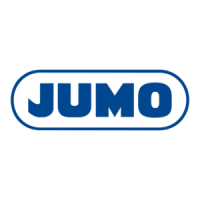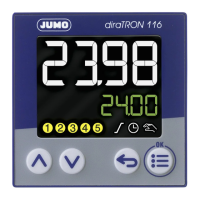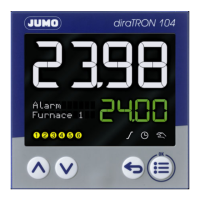19
5 Noncyclical data exchange
5 Noncycl ical dat a exchange
CAUTION!
All temperature values of the JUMO IO device are transferred in the unit "°C".
Misinterpretation of measured values of a JUMO IO device in the IO controller can cause errors in the
system control.
Note the unit for the transferred temperature values!
5.1 Programming the noncyclical data exchange in the IO controller
In addition to the cyclical data exchange between IO controller and IO device in the RT channel, PROF-
INET IO also offers the option of event-controlled noncyclical data exchange. The noncyclical communi-
cation is controlled by the IO controller (similar to the master-slave principle) via write/read requests and
has to be implemented by the user. Noncyclical data are provisioned by PROFINET IO users as "Record
Data". The transfer occurs in the NRT channel.
For the programming of write/read requests, the engineering systems of the various manufacturers con-
tain libraries with relevant function blocks such as "RDREC" (Read Record) and "WRREC" (Write Re-
cord).
With JUMO PROFINET IO devices, the write/read requests do not access the "Record Data" directly.
Instead, they transfer data exchange packets between IO controller and IO device, which are further pro-
cessed in the background by the field devices. For an IO controller to be able to exchange noncyclical
data with a JUMO IO device, appropriate data structures (data blocks/data type objects) have to be cre-
ated in the IO controller for the data exchange packet concerned. These data structures provide the
memory for the outgoing and incoming data exchange packets. Data exchange packets are identified by
an index, which has to be transferred to the write/read function blocks in the form of parameters. JUMO
PROFINET IO devices have 3 indices for 3 different types of data exchange packets, which are trans-
ferred via the write/read commands. The table below lists the available indices of JUMO field devices.
Within a data exchange sequence, the IO controller transfers a data exchange packet to the IO device.
The IO device processes the data exchange packet and re-provisions it for pick-up by the IO controller
(response with data or status messages). In order to control processing by the IO device (e.g. defining
the data direction and selection of noncyclical data), the data exchange packet must be parameterized
accordingly.
With JUMO IO devices, the noncyclical services are always assigned to Slot 1. In JUMO IO devices,
Slot 1 is always pre-configured. Consequently, the noncyclical services are not dependent upon the
module configuration or project planning in the IO controller, and are available as soon as the system
has successfully booted.
Index Data exchange packet Explanation
201 Single-ID For the write and read transfer of single noncyclical data points
with a length of up to 243 bytes within a data exchange se-
quence
Length of the data exchange packet: 255 bytes
202 Multi-ID For the write and read transfer of multiple noncyclical data
points within a data exchange sequence, the single data points
are allowed to be up to 4 bytes long.
Length of the data exchange packet: 640 bytes
203 Program memory For the write and read transfer of program memories (on pro-
gram controllers) within a data exchange sequence
Length of the data exchange packet: 1024 bytes
